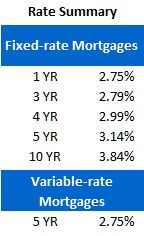David Larock in Mortgages and Finance, Home Buying, Toronto Real Estate News
 This week’s update will use an ‘around the horn’ format to highlight several interesting developments that related to the Canadian mortgage market and borrowing rates last week:
This week’s update will use an ‘around the horn’ format to highlight several interesting developments that related to the Canadian mortgage market and borrowing rates last week:
Taming the Housing Beast
The Canada Mortgage and Housing Corporation (CMHC) issued a release that warned it would try to rein in the explosive growth of its insured mortgage portfolio in the coming years (CMHC grew by $170 billion from 2007-10). While much of the tightening will occur behind the scenes, by limiting the amount of bulk-portfolio insurance that lenders can purchase on what are deemed to be lower-risk loans, this new mandate will limit flexibility and increase the cost of borrowing for different sub-groups of mortgagors over time.
Clearly CMHC is concerned about fueling an over-heated housing market and while this announcement may not come as welcome news to many real-estate industry professionals, it is a prudent and measured change that can be implemented over time. Something had to be done and if you’re trying to engineer a ‘soft-landing’ for our housing market, this seems like the right approach.
Meanwhile, the Office of the Superintendent of Financial Institutions (OSFI), otherwise known as Canada’s banking regulator, issued a draft paper that proposed several changes to the underwriting practices and procedures used by our banks and other federally regulated lenders. This was big news in the mortgage world and if the recommendations in the report are implemented, they will significantly alter our lending landscape.
While I would describe the ongoing changes at CMHC as having been made with a scalpel, OSFI’s recommendations look more like a sledgehammer approach to regulation. I’ll need a full post to adequately deal with OSFI’s report and to that end, I’ll try to put something together this week.
Keeping Inflation Under Control
Statistics Canadareleased its latest Consumer Price Index report on Friday. Overall inflation rose to 2.6% in February, up from 2.5% in January. While the increase was primarily led by higher energy prices, core inflation also rose by 2.3%, compared to 2.1% in January. (Reminder: core inflation strips out more volatile factors like food and energy costs.) Both numbers were a little higher than expected but experts noted that the increase was not nearly as pronounced when adjusted for seasonality.
Looking for Signs of the Global Recovery
The hangover from the euro zone’s last-one-in-is-a-rotten-egg liquidity party, otherwise known as the European Central Bank’s trash-for-cash Long-Term Refinancing Operation (LTRO), appears to be kicking in. Both Italian and Spanish ten-year bond yields are back above 5%, which is concerning, in light of their large ongoing budget deficits, and surprising, given how much extra liquidity has just been pumped into the euro zone’s financial system. I smell yet another ministers’ meeting and photo op announcing that the end of the crisis is on the way.
On our side of the pond in theU.S., the string of recent positive data has investors reconnecting with their bullish animal spirits but U.S. Fed Chairman Ben Bernanke sounds less convinced that the U.S.recovery is firmly underway. In a speech at GeorgeWashingtonUniversity last week, he said that consumer spending is still “quite weak” and that there are still “a lot of issues to be resolved”. Chairman Bernanke also reiterated his long held belief that the Fed exacerbated the Great Depression by tightening U.S.monetary policy too quickly, and he didn’t give any indication that he plans to change his current strategy of keeping rates low until late 2014.
Five-year Government of Canada (GoC) bond yields were down 9 basis points for the week, closing at 1.65% on Friday, and not a moment too soon for lenders caught between shrinking profit margins and the siren song of spring mortgage-market competition. While only a few promotions have been pulled so far, with yields at these levels, the threat of increased fixed-mortgage rates still looms. If you are in the market for a fixed-rate pre-approval, you’re still well advised to get ‘em while they’re hot.
Variable-rate mortgage discounts still aren’t deep enough to justify taking on floating-rate risk.
The bottom line: While CMHC’s decision to curtail the growth of its insured mortgage portfolio will be phased in over time, more onerous lending rules from OSFI could hit the housing market with a pronounced thud. In fact, there is a risk that some of OSFI’s tighter controls over mortgage lending could cause the very correction in house prices that the OSFI is trying to prevent. Stay tuned.
On the economic-recovery front, higher Spanish and Italian bond yields and cautious comments by U.S. Fed Chairman Bernanke were actually somewhat positive omens for Canadian mortgage rates. Ongoing euro-zone uncertainty will ensure there is still plenty of demand for the safety of GoC bonds (which will keep fixed-mortgage rates low), and the continuation of the U.S.’s loose monetary policy will help keep short-term Canadian borrowing rates in check.
David Larock is an independent mortgage planner and industry insider specializing in helping clients purchase, refinance or renew their mortgages. David's posts appear weekly on this blog (movesmartly.com) and on his own blog integratedmortgageplanners.com/blog). Email Dave



